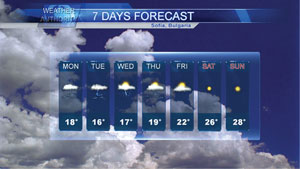Channel branding
Channel branding has been in existence for as long as there have been channels, except for several decades it was referred to as station identification.
In the early days, TV branding was simple. It had to be. Even in the early 1970s, a VTR cost as much as a row of houses, and there were no viable computer graphics. Cometh the channels, cometh the technologies!
Today hundreds of TV channels are easily accessible, affordable technology for branding is in a totally different league of availability and affordability, and branding exists whether we like it or not. However, such power needs to be used with discretion. Good branding gives the viewers a good impression, and so creates a bias toward that channel. Rather than leaving viewers to come to their own conclusions, broadcasters can then actively manage that impression and expand the branding as the channel becomes more popular.
Bugs — good and bad
There are many ways a channel can brand itself and typically, for a major channel, all methods are used. The channel ID, or bug, usually placed in the top left or right corner, is most popular. Aesthetically, this has to do its job of labelling the channel without distracting viewers from watching the program. It’s up to the graphic designer to get it right. Technically, displaying the bug involves keying a graphic over the channel’s output, perhaps in a downstream keyer. Some are transparent; some are solid. Today we would hope the keying avoids producing ragged edges, implying some profiled key rather than the old hard key. To achieve this 40 years ago using the equipment of the time was not easy. Today it can be simple and inexpensive.
Some channels like to animate the bug. This means there must be some form of video replay to run this video and key. As humans are historically hunter-gatherers, and so programmed to notice movement — even in peripheral vision — viewers are bound to be distracted by the bug. This may be counterproductive and turn the viewer away.
This simplest form of branding is important as viewers should immediately, or within milliseconds, recognize the channel by the bug/logo when surfing the many available channels. However, the bug is very basic and not likely to encourage viewers to watch and stay loyal to the channel. So there is usually a range of other elements that make up the complete channel branding package.
The professional video industry's #1 source for news, trends and product and tech information. Sign up below.
Creating a brand
Channel branding is much more than establishing an identity; it is about creating a brand that will get viewers to watch the channel and keep watching, as well as recommend the channel to others. Multichannel broadcasters will want to promote across all their channels and platforms. Channel branding is all about gaining viewers and keeping them watching your channels and, for commercial channels, increasing revenues.
Competition for viewers is greater than ever, so channels are demanding ever more powerful ways to promote their brand within what is usually an extremely limited budget. The good news is that, today, with the advances in technology, the process of achieving the required on-air look can be flexible and high quality. At the high end, many branding systems, including some channel-in-a-box (CIB) systems, can meet and exceed the requirements cost-effectively. Unlike the early days, the on-air technology no longer limits channel-branding presentation. This throws the challenge back to the artists, designers and even the accountants, to supply effective branding materials, as, from the broadcast engineering position, we can present it on-air. It is up to the channel’s creative powers, not the technology.
Typically, graphics experts will have produced the designs, and these designs need information — text to be added when it goes to air. Using traditional TV equipment for video, stills, text, animation, on-air mixing, keying, sizing, positioning, timing and sequencing, it can get complicated to do this live. For this reason, the packages are pre-recorded so all that has to happen to put the piece to air is simply to replay the clip and cut it on-air. That is possible with clips of some length, but attempting to cue a two-second bumper or sting — all a part of the on-air look — would be asking too much of VTRs. One way around this is to pre-record every break — sacrificing flexibility and increasing workload. Another is the cart machine, a mighty, elaborate electromechanical wonder that could do the job, but at a considerable cost.
Flexibility
Today with the agility of disk storage, CIB, and other file-based playout and graphic systems, the whole workflow changes, becoming more efficient, much lower cost and reliable. What stays the same are the original graphic elements and their choreography, which are designed by experts. But now they are created on computers and delivered as files. Any additional branding elements can be pre-programmed and added live on-air with up-to-date information from last-minute scheduling or from Internet or metadata. The dynamic display of the graphics, videos, new text, etc. is run live by the on-air graphics engine.
Given the flexibility of modern on-air graphics systems, there are many ways the channel can grab the viewers’ attention and deliver the message that will keep them on-channel. For example, as one program is finishing a quick crawl, a lower third or squeeze back can show the ‘Coming Up Next’ — or, for multichannel broadcasters, ‘Starting Now On ...’ — messages over the end credits. This can be effective with, or without, a voice over. However, waiting until the program ends is too late, as viewers could already be scanning other channels. Of course, the content of the message is important; giving information about upcoming similar programs could well attract current viewers.

New branding technology allows news channels to create templates for current weather information, for instance, by taking metadata from the Internet.
Channel branding vehicles can comprise items such as trailers, break bumpers, line-up menus, forthcoming programs, and cross-platform and cross-channel branding. But all this needs to be delivered in such a way as not to disturb or deter viewers from watching the channel. For instance, music channels create templates for the singer/group and song title. Different templates are often used for different shows, but the information comes from the metadata of the clip, or from the MAM, and is automatically shown after the clip starts and again near the end. Also using the same metadata or MAM, the coming-up-next clips can be created and shown, even if the music clips are interactive and shown in viewer-rating order.
News channels can create templates for latest information. This can be news tickers, share prices, weather and exchange rates. These may take the metadata from a database, or the Internet, to keep the information current. Information can be shown concurrently or sequentially with added graphics generated by the computer. So arrow-up, arrow-right and arrow-down graphics can indicate the direction of share-price movement from the last-shown data or from the day’s opening prices.
Remote channels
The most developed CIB systems can comprise just commercial off-the-shelf hardware and CIB software. Given reliable operation, playout systems based on this technology can run fully redundant automatic remote playout anywhere in the world via the Internet. This can make delivering a TV station anywhere, complete with local branding and content, an economic reality, even for small audiences. It enables the whole operation to be run from an established broadcast center to worldwide locations at a cost that makes sense.
Advertisement insertion systems allow network content to be locally branded. Targeting advertisements for specific audiences with ad insertion and digital program insertion, a station can use local or network advertising to maximise the business potential for the local audience.
All in a box
Some CIB systems offer a cost-effective turnkey file-based solution that combines video playback and rich branding graphics — both generated from the same box. Then good graphics and some simple programming is all that is needed for the channel to be considered one of the best available.
Modern viewers
Today’s viewers are far better equipped than in past decades. Many have PVRs and tend to watch programs later. They will skip adverts and many of the channel-branding messages that link the programs. This is another reason for the branding to start before the program ends — even before the final credits. A strap or crawl in the final minutes of the program is becoming more commonplace, as are lower thirds. Lower thirds, however, really need to be previewed to make sure that they do not interfere with the program. That can make this option more labor-intensive.
Cross-platform branding is also popular with most channels. Having a website available for viewers to watch other programs has distinct advantages, as there is no PVR to fast forward over the adverts and branding messages. Websites are also there to sell channel-branded and other third-party products, giving the broadcaster another branding opportunity.
Social media also plays a key role in channel branding. It allows users to create, share and exchange information and ideas. Many viewers comment about programs they are watching on Twitter, Facebook, LinkedIn and MySpace using hash tags. These hash tags allow channels to access more branding opportunities, as well as deliver messages to both viewers and their social media contacts.
Today many TV channels are integrating social media into their programs, so to appear more live and interactive with their viewers (although many are computer-generated with basic moderation to remove unwanted messages). A modern NRCS can take feeds from news wires but can also handle social message feeds for the news program, website and back to the social media feeds.
Channel branding is here to stay, and it will continue to be a challenge for broadcasters who strive to achieve the best branding at the least cost. All TV channels realize that the better the channel branding, the better the bottom line. Now, the second screen also has to be incorporated into the channel-branding package, but automation has to play a critical part in channel branding, otherwise costs will rocket.
Branding is also about having good programs. Good branding cannot make up for bad programs; however, good branding can make a channel seem better than others showing similar programming. This is especially important for, say, music channels that have access to essentially similar music videos. Here branding can, and does, make a difference.
—Don Ash is managing partner and director of sales at PlayBox Technology.
